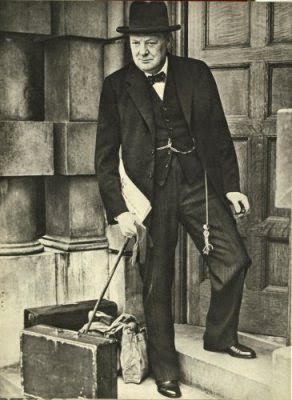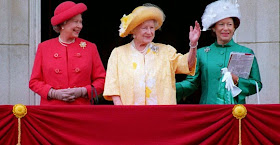 |
The Rt. Hon. The Baron Strathcona and Mount Royal,
GCMG, GVCO, PC, DL (1820-1914) |
Today, 21 January 2014, marks the centenary of the death of one of the towering figures of the British Empire: the great Canadian imperialist, philanthropist, businessman and politician, Donald Smith, 1st Baron Strathcona and Mount Royal, GCMG, GCVO, PC, DL.
Having achieved phenomenal success, wealth and power in Canada, Lord Strathcona spent his final years in London. Appropriately for a great architect of the British Empire, his funeral service was conducted at Westminster Abbey, where a commemorative stained glass window remains to this day.
Lord Strathcona's imposing mausoleum stands near the entrance to London's famed Highgate Cemetery.
Despite his extremely long, successful and varied career, Lord Strathcona is perhaps best remembered for driving "The Last Spike" into the transcontinental Canadian Pacific Railway, the construction of which was essential for the creation of modern Canada and became a symbol of national unity.
The photograph taken of Lord Strathcona on that occasion (shown below) remains one of the iconic images of Canadian history and is regarded as a symbol of national pride and achievement.
 |
Arguably Canada's most famous and historically significant photograph.
"The Last Spike": Lord Strathcona & Mount Royal drives the final spike into the Canadian Pacific Railway, 7 Nov. 1885.
Unlike the final spikes used to complete other railways, The Last Spike in the Canadian Pacific Railway was neither gold nor silver but was identical to the millions of other spikes that had been laid along the route. |
Born in Scotland in 1820, Donald Smith emigrated to Lower Canada at the age of 18 to take up a position with the Hudson's Bay Company. He steadily rose through the ranks of the Company whilst simultaneously finding time to successfully stand for election: first to the Manitoba legislature and subsequently to the Canadian House of Commons, where he sat intermittently from 1871 through to the 1890s, staunchly defending the Hudson's Bay Company. Smith would eventually become a commissioner of the Company, its principal shareholder and, ultimately, its 26th Governor -- a position he held until his death. His 75 year record of service with the Hudson's Bay Company remains unequalled.
 |
Plaque commemorating
"The Last Spike" |
A silent, but substantial, partner in the syndicate that founded the Canadian Pacific Railway, Smith became a director of the company in 1883 and had the honour of driving the Last Spike into the transcontinental railway 5 years later. During this same period, Smith, who had earlier helped established the Bank of Manitoba, was appointed to the board of the Bank of Montreal (1872), subsequently becoming Vice President (1882) and President (1887).
In 1896 Smith declined the offer to succeed Canadian Prime Minister Sir Mackenzie Bowell and, instead, accepted appointment as Canada's High Commissioner to the United Kingdom. A month after his appointment he was elevated from Knight Commander of the Order of St. Michael and St. George (1886) to Grand Cross of the Order (GCMG) in The Queen's Birthday Honours List. A year later he was created
Baron Strathcona and Mount Royal, of Glencoe in the County of Argyll and of Mount Royal in the Province of Quebec and Dominion of Canada.
Continuing his business interests, Smith helped to establish the Anglo-Persian Oil Company (the forerunner of British Petroleum / BP) and would become its chairman in 1909.
During his service as High Commissioner in London, Lord Strathcona raised a private unit of Canadian soldiers to fight in the Second Boer War. One of the last private regiments to be established during the British Empire,
the Strathcona Horse was recruited and equipped at Lord Strathcona's expense.
 |
| Lord Strathcona's Horse (Royal Canadian) in ceremonial uniform today |
According to tradition, the famous "Strathcona Boots" worn in dress uniform by the Royal Canadian Mounted Police were adopted by the Mounties after they served with the Strathcona Horse during the Boer War. The famous stetsons worn by the Mounties were also allegedly inspired during this period, perhaps from the Strathcona Horse. Disbanded in 1901 and revived in 1909, with augmentations to its name,
Lord Strathcona's Horse (Royal Canadians) exists today as a regular armoured regiment of the Canadian Army with HRH The Prince of Wales as its Colonel-in-Chief.
In keeping with the spirit of the age, Lord Strathcona became one of the Empire's greatest philanthropists, using his wealth to support organisations in the UK, Canada and across the Empire. With his cousin and Canadian Pacific Railway partner Lord Mount Stephen, Lord Strathcona funded the construction of Montreal's famous Royal Victoria Hospital. Established in 1893 "to be for the use of the sick and ailing without distinction of race or creed", the "Royal Vic" was the most advanced and best equipped hospital in North America. The hospital exists to this day and is closely affiliated with that other great Montreal institution, McGill University. A major benefactor to McGill, Lord Strathcona established a school for women there in 1884 and would become Chancellor of the University from 1888 until his death.
 |
The stunning Imperial Institute. Nothing remains of the original building save for the
tremendous tower. The rest of the buildilng was destroyed by architectural vandals to
redevelop the site for Imperial College |
In Britain his philanthropy contributed to Aberdeen University, the Sheffield Scientific School and the Imperial Institute (later the Commonwealth Institute), the original site of which is now home to Imperial College in South Kensington. He also contributed generously, along with his cousin Lord Mount Stephen, to The Prince of Wales Hospital Fund (now The King's Fund). In 1908 King Edward VII (who regarded Lord Strathcona as a friend) appointed him a Knight Grand Cross of the Royal Victorian Order (GCVO).
 |
The Lord Strathcona Medal,
the highest award that can be conferred on
a Canadian cadet.
The Medal bears the bust of Lord Strathcona |
Through Lord Strathcona's generous endowment to the Royal Canadian Army Cadets and his desire to promote patriotism, the Lord Strathcona Medal was established as the highest award that can be bestowed upon a Canadian cadet. Today it continues to be conferred in recognition of outstanding performance in physical and military training.
 |
| Knebworth House, leased by Lord Strathcona and Mount Royal until his death |
In England, Lord Strathcona lived at 53 Cadogan Square in London and leased Knebworth House until his death. In Scotland he owned Glencoe House and Colonsay House (having purchased the Inner Hebrides island of Colonsay in 1905, which remains in the possession of the family today). In Montreal Lord Strathcona lived at 1157 Dorchester Street in the famous Golden Square Mile.
Lord Strathcona's memory lives on through numerous portraits, memorials, streets, parks and municipalities in Canada.
In Britain his memory endures though the memorial stained glass window erected in Westminster Abbey (see below) and also at his imposing Mausoleum in London's celebrated Highgate Cemetery.
 |
Westminster Abbey's Memorial Window to
Lord Strathcona & Mount Royal
Dedicated on Dominion Day, 1 July 1919
(five years after Lord Strathcona's funeral in the Abbey)
The window is inscribed:
"In Memory of Baron Strathcona & Mount Royal. B. 1820. A Great Canadian Imperialist and Philanthropist. D. 1914"
The window displays the armorial bearings of Canada, the Hudson's Bay Company, Lord Strathcona & Mount Royal, the University of McGill and the University of Aberdeen, as well as the shields of Quebec and Manitoba and the regimental badges of Lord Strathcona's Horse (Royal Canadians) and the Liverpool Scottish (The King's)
|
 |
Mausoleum of Lord Strathcona and Mount Royal
in Highgate Cemetery, London.
Lord Strathcona's mausoleum is one of the most imposing in the historic cemetery
and occupies a prime position by the entrance. |














.jpg)









.jpg)




























